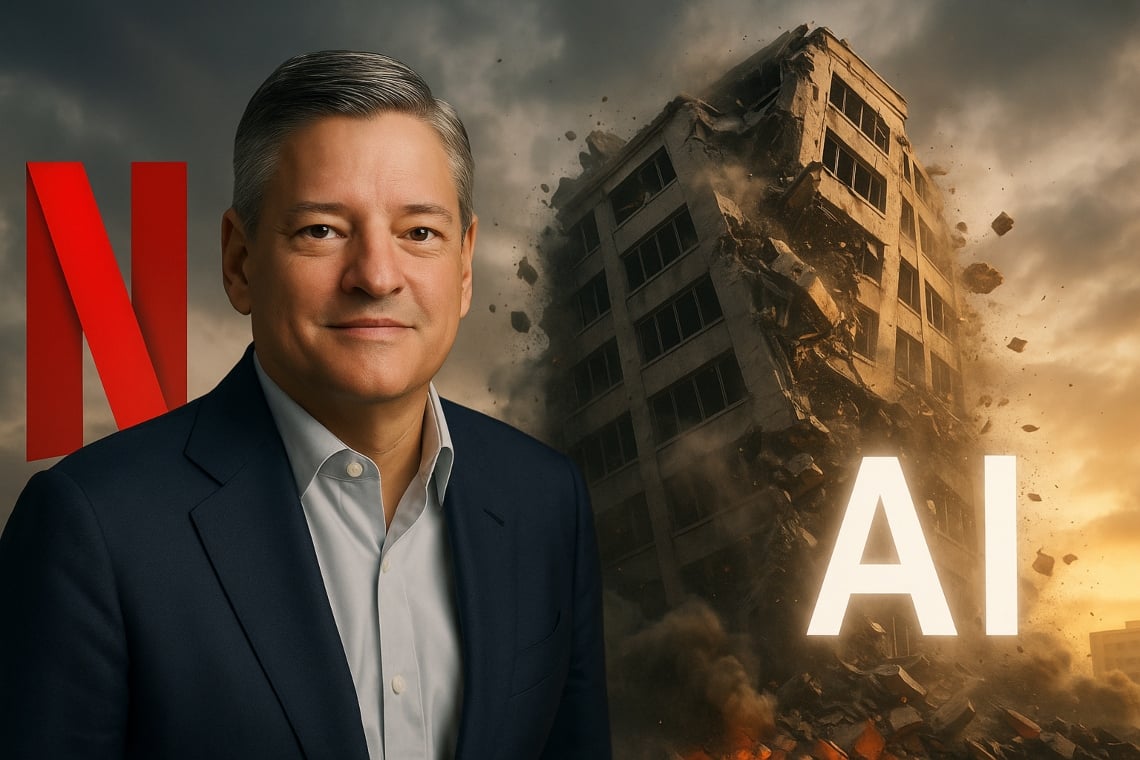Netflix takes a decisive step towards the future of audiovisual production, introducing GenAI in its films and shows for the first time.
The announcement comes directly from co-CEO Ted Sarandos during the company’s recent post-results conference call, marking a historic moment for the entire entertainment sector.
The streaming platform has indeed revealed that it used generative artificial intelligence to create a key scene in the Argentine series “El Atonata,” paving the way for new creative and production possibilities.
The innovation of Netflix: GenAI on the screen
The first tangible example of this technological revolution is found right in “El Atonata,” where Netflix’s in-house production team collaborated with the creators of the series to create a complex scene of a building collapsing.
Thanks to the use of GenAI, the sequence was completed in record time: according to Sarandos, the work was completed ten times faster compared to traditional visual effects tools, with significant cost savings.
This result not only demonstrates the effectiveness of the new technology, but also highlights how artificial intelligence can become a fundamental tool for creators, allowing them to overcome technical and budgetary limits that until recently seemed insurmountable.
Sarandos emphasized how Netflix’s mission is to provide its creators with increasingly advanced tools, capable of improving the quality of films and series, and not just reducing their costs.
“We remain convinced that artificial intelligence represents an incredible opportunity to help creators make films and series better, not just cheaper,” stated the co-CEO.
The adoption of tools based on artificial intelligence indeed allows for the democratization of access to technologies that, until recently, were reserved exclusively for projects with the highest budgets.
An example is de-aging, or the digital rejuvenation of actors, which can now be used even in medium-scale productions thanks to GenAI.
The impact of artificial intelligence, however, is not limited to visual effects.
Netflix is already experimenting with the use of GenAI in the pre-visualization and planning of shoots, offering creators the opportunity to test and refine their ideas even before arriving on set.
This innovative approach allows for the optimization of time and resources, reducing unforeseen events and increasing the quality of the final product.
Personalization and ads: AI also transforms the user experience
The innovation of Netflix does not stop at content production. Co-CEO Greg Peters has indeed revealed that the company is using artificial intelligence in other strategic areas as well, such as personalization, search, and the management of advertising.
The goal is to offer users an increasingly tailored experience, anticipating tastes and preferences through advanced data analysis.
A concrete example is the launch of artificial intelligence-based search, introduced at the beginning of the year, which allows subscribers to more easily find content of interest to them.
Furthermore, Netflix aims to launch interactive ads in the second half of 2025, leveraging the potential of AI to make advertising more engaging and effective. The adoption of artificial intelligence is part of a context of strong growth for Netflix.
In the second quarter of 2025, the platform recorded a revenue of 11.08 billion dollars, with an increase of 16% compared to the previous year. The profit reached 3.13 billion dollars, confirming the financial solidity of the company.
The data related to content consumption are also impressive: in the first half of 2025, users watched over 95 billion hours of movies and series, with non-English titles accounting for one-third of all views.
A clear signal of the growing internationalization of the platform and its ability to attract increasingly diverse audiences.
The future of audiovisual production according to Netflix
The entry of GenAI into the production of films and series marks a turning point for the entertainment industry.
Netflix once again confirms itself at the forefront in the adoption of new technologies, aiming to improve not only production efficiency but also the quality and variety of the content offered.
The challenge for the future will be to continue innovating, keeping at the center the talent and creativity of the professionals in the sector, who will be able to rely on increasingly powerful tools to bring their visions to life.
Artificial intelligence does not replace human work, but enhances it, opening up new scenarios for the cinema and television of tomorrow.
